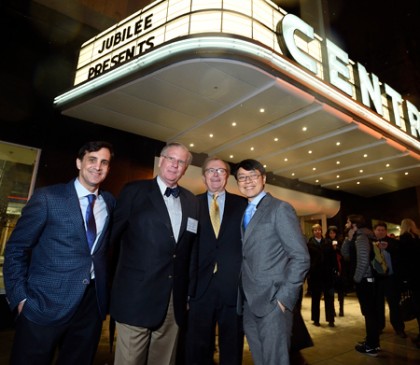The long-vacant Centre Theatre located about a mile south of Johns Hopkins' Homewood campus, was alive with activity Tuesday evening at a ceremonial marquee lighting celebrating its nearly complete renovation.

Image caption: Johns Hopkins University President Ronald J. Daniels (left) with Charlie Duff, president of Jubilee Baltimore; Timothy Armbruster of the Central Baltimore Partnership; and Sammy Hoi, president of the Maryland Institute College of Art.
Image credit: Will Kirk / Johns Hopkins University
The century-old building will soon be home to a film and audio facility to be co-managed by Johns Hopkins and the Maryland Institute College of Art. JHU and MICA students will gather there to think about the artistic pairing of sights and sounds. Johns Hopkins and MICA are sharing the $10 million cost for an initial 10-year lease of the roughly 25,000-square-foot second floor and a build-out to include recording studio, soundstage, screening rooms, editing suites, and classrooms. The collaboration—between the JHU's Krieger School of Arts & Sciences, the Peabody Institute, and MICA—is to be known as the Johns Hopkins–MICA Film Center.
Opened in 1913 as a car dealership, the Centre—located at 10 E. North Avenue between Charles and St. Paul streets—operated as a theater from 1939 to 1959. It was sold at auction in 2012 for $93,000 to Baltimore developer Charlie Duff, whose nonprofit development firm Jubilee Baltimore has worked to rehab hundreds of Baltimore rowhouses. In addition to Johns Hopkins and MICA, other tenants of the renovated Centre Theatre are expected to include the Baltimore Jewelry Center, five nonprofits, and—Duff announced Tuesday—video game developer Sparkypants Studios.
Also see: Centre Theatre nears reopening (The Baltimore Sun)
A block away, the Parkway Theatre is in the midst of its own facelift—the long-neglected 1915 movie palace is slated for a $17 million renovation into a three-screen, 600-seat film center that will be the new home of the Maryland Film Festival. Johns Hopkins recently received a $5 million gift from the Stavros Niarchos Foundation to be used for the theater, which will also have facilities for Hopkins and MICA film students.
The Centre and Parkway theaters are in the Station North Arts and Entertainment District, a roughly 20-block chunk of midtown where state tax breaks and other incentives have already brought changes to an area long scarred by vacancy. Since the area's arts designation in 2002, boards have come off windows and lights turned back on in galleries, performance venues, and arts-oriented restaurants and cafes.
Investing in the district aligns with the Homewood Community Partners Initiative, a collaborative effort with area stakeholders and civic leaders that the university launched two years ago to improve conditions within 10 neighborhoods near Homewood. Johns Hopkins has pledged $10 million—and the partnership has raised an additional $14 million—to support activities and projects that strengthen the 10 communities.
Posted in Arts+Culture, University News










